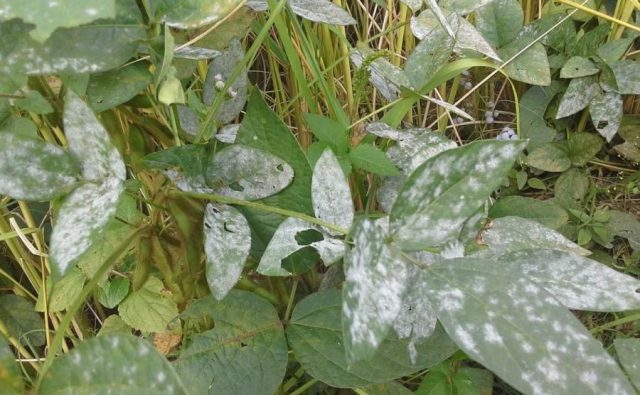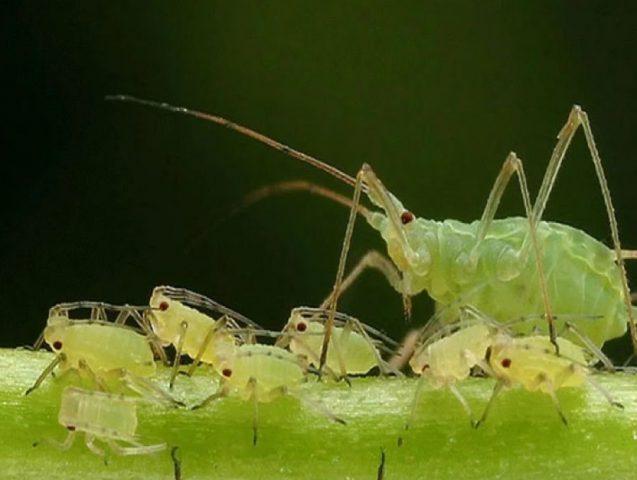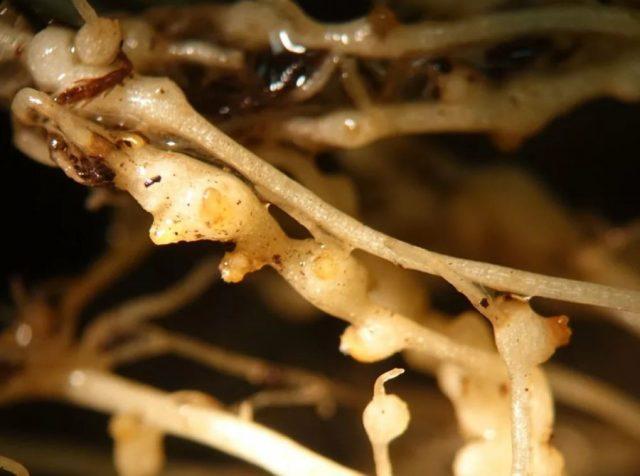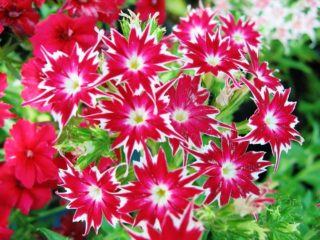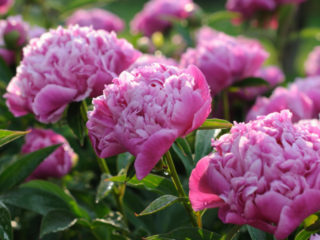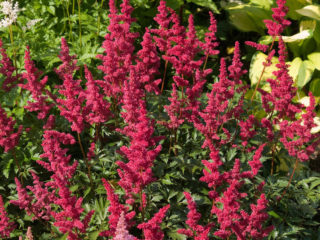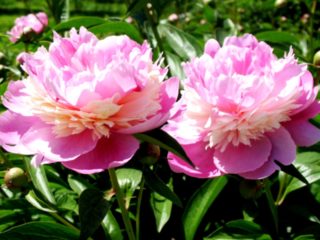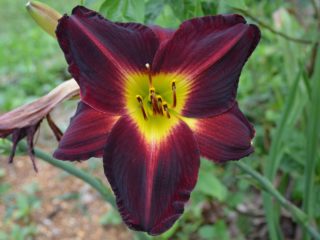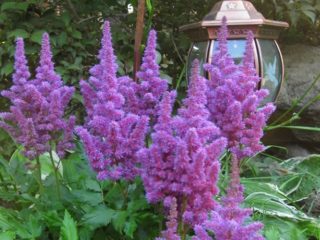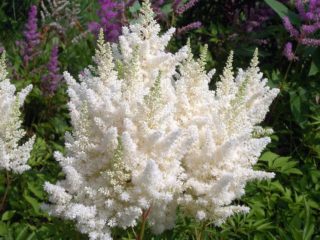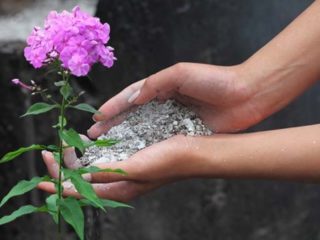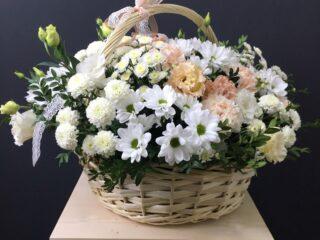Content
Photos of tritelia show a beautiful herbaceous plant that blooms with colorful flowers in early summer. Before planting a crop in your dacha, you need to study its features and basic requirements.
Description of tritelia
Triteleia is a herbaceous perennial of the Asparagus family. It has medium-sized stems up to 70 cm above the ground. The underground part is represented by corms up to 2.5 cm in diameter, covered with brown or beige dry scales.
The leaves of the plant rise vertically from the base, have a linear or narrow-lanceolate shape and a smooth surface. They reach a length of 20-70 cm, a width of only about 10 cm. At the tops, the leaves gradually taper, their tips remain rounded.
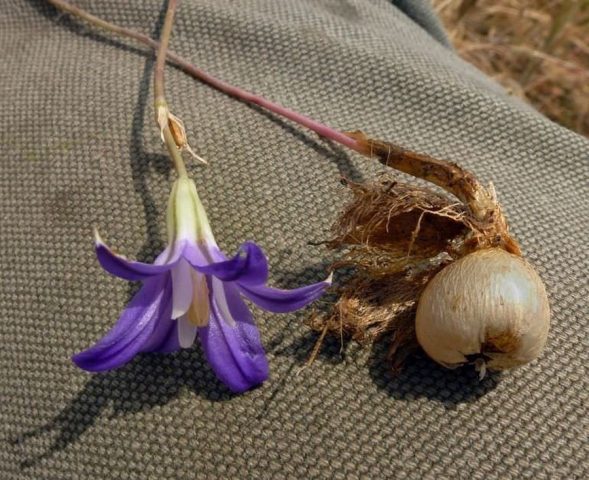
The corms of the tritelia plant are edible and taste similar to potatoes
In early June, the tritelia plant produces a peduncle up to 50 cm in height. At the top of the stem, snow-white, bluish, pink, purple or yellow buds bloom, collected in umbrella inflorescences. The corolla is funnel-shaped or bell-shaped. Flowering continues for several weeks until mid-summer; in favorable conditions, trithelia can bloom again in October. At the end of the decorative period, the plant forms fruits - egg-shaped boxes filled with black granular seeds, ribbed on one side.
In its natural form, Trithelia is found mainly in North America - in California, Nevada, Washington, Idaho and Montana. The plant settles in open spaces or in slightly shaded areas.
Winter hardiness of tritelia
Decorative tritelya has average frost resistance. In open ground, the plant can withstand cold temperatures down to -25 °C. In the middle zone, the crop requires careful shelter for the winter.
Types and varieties
Bulbous trithelia is represented by numerous species. You can list several of the most popular plants for open ground and growing in pots.
Trithelia loose
In the photo, Triteleia laxa looks like a tall perennial up to 70 cm above the ground with long and narrow rich green leaves. From late April to June, the plant blooms with pale blue, bluish or white, tubular-type flowers. The species is native to California; Tritelia is found in mixed forests and wet meadows.
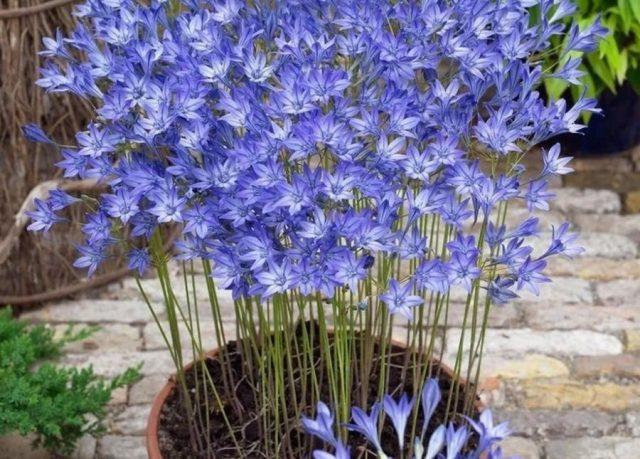
Loose trithelia can withstand cold temperatures down to -28 ° C
Ixiiform
Tritelia ixioides is a species of plant that reaches up to 40 cm above the ground.It bears pale yellow flowers, collected in umbels at the tops of the stems, with purple veins visible on the petals.
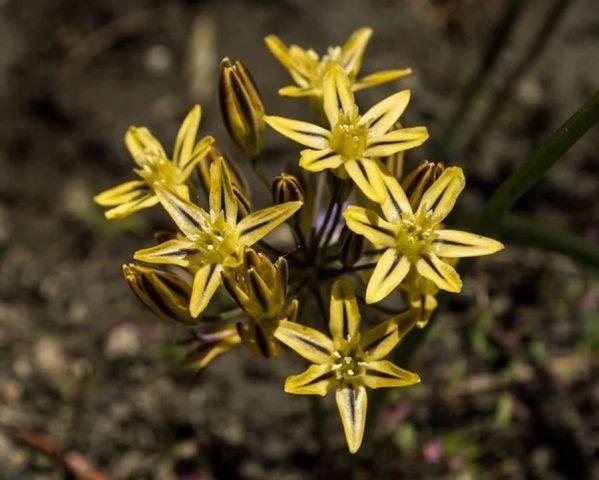
Trithelia Ixiiformes blooms in June and July
Lemon
Triteleia lemmonae is a North American endemic plant species. It has bright yellow flowers with dark stripes. In the center of the buds there are long arrow-shaped anthers.
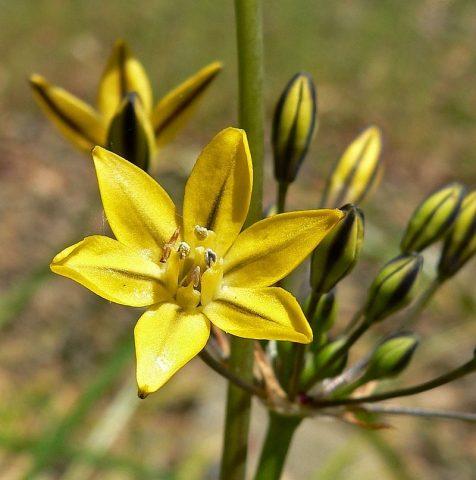
Lemon tritelia grows naturally only in the pine forests of Arizona.
When to plant tritelia
Planting of tritelia bulbs is carried out in the spring from April to the end of May or in the fall from September to early November. In the southern regions and Central regions, the procedure is prescribed at an early date, but it is necessary to take into account the weather in a particular season.
It is quite difficult to grow tritelia in Siberia; it is recommended to wait until mid- or late-May for planting. The soil must thaw and warm up properly; you need to wait until the night frosts pass.
How to plant tritelya
To plant tritelia in the spring, choose an open, well-lit place or an area with openwork shading. It is necessary to take care of protection from drafts - the plant does not like cold winds. Tritelya does not respond well to planting in lowlands, close to groundwater or in dense shade. In this case, flowering indicators deteriorate, the crop begins to wither and become sick.
Tritelya needs light, well-moistened and nutritious soil. The optimal acidity level for the plant is 6.5-7 pH. The substrate can be prepared from garden soil, peat and river sand, taken in equal proportions.
Direct planting of decorative crops is carried out according to the following scheme:
- The site chosen for the plant is carefully dug up, humus and minerals are added to the soil.
- Prepare tritelium holes up to 10 cm deep for planting and pour a drainage layer on their bottom.
- Fill the holes up to half with soil mixture.
- Place the tritelia plant bulb in the center of the recesses.
- Fill the remaining voids with substrate and lightly compact it with your hands.
Immediately after planting, tritelya requires abundant watering. It is not recommended to deeply bury the tubers, as this will slow down germination.
Caring for tritelya in open ground
When growing tritelia in open ground, it is necessary to pay attention to several agrotechnical measures. The culture is not considered capricious, but requires basic care.
Watering
Tritelya loves moderate moisture. When caring for the plant, water it as the soil dries. During flowering, the intensity of moisture application is increased to 3-4 times a week. Trithelia reacts negatively to drought, and its decorative properties are sharply reduced.
After each watering, the soil at the roots of the plant is carefully loosened with a rake. The procedure inhibits the growth of weeds and also improves soil aeration.
Fertilizer
After planting loose tritelia and when caring for it, you need to pay attention to fertilizing. For the first time, fertilizer is applied at the stage of deepening the bulbs into the soil; humus or leaf compost is added to the soil. About two weeks after planting, the plant is watered with a solution of urea or nitroammophoska. During the flowering period, tritelia needs the addition of superphosphate and potassium minerals.
Trimming
The tritelia plant does not need decorative pruning.But at the same time, during the summer it is recommended to promptly pick off wilted inflorescences. This will extend the decorative period, since the crop will free up resources for the formation of new buds.
Wintering of tritelia
In the southern regions and in the Moscow region, the tritelia plant can overwinter in open ground. With the onset of autumn, it is only recommended to cover the wilted perennial with sawdust or dry leaves, and lay spruce branches on top.
In Siberia and the Urals, tritelia requires digging up for the winter. The bulbs need to be carefully removed from the soil and cleaned of any remaining soil, and then laid out on paper or a clean cloth and dried a little. Then the tubers of the tritelia plant are placed in boxes and sprinkled with sawdust, after which they are put away until spring in a dark, cool room with a low level of humidity.
Reproduction methods
Trithelia reproduces in two main ways. The crop is grown not only from bulbs, but also from seeds. In the latter case, the plant begins to bloom later, but is characterized by higher endurance.
Propagation by corms
Most often, tritelya is propagated on the site by children, or small bulbs formed on the mother tuber. The algorithm looks like this:
- In the fall, after wilting, the plant is dug out of the ground and the children are separated from the main bulb.
- All planting material is sent for storage in a dry, dark cellar until spring.
- In April or early May, plant bulbs are removed from a box of sawdust.
- For tritelia children, disinfection is carried out with a light solution of potassium permanganate.
- Plant the material in prepared holes in the garden.
If desired, the bulbs can be placed in home boxes at the beginning of March and grown until the final warmth arrives.But gardeners note that tritelia develops better if it is transferred directly to the ground without intermediate steps.
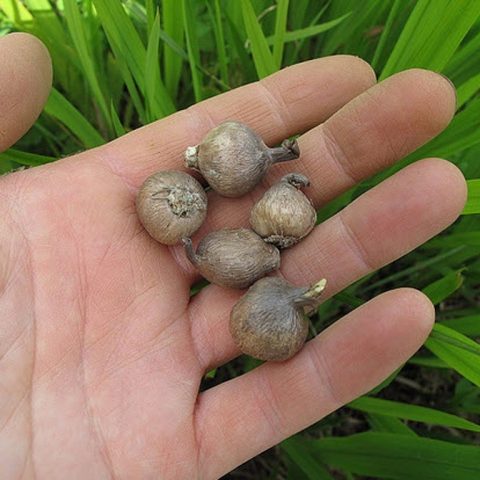
It is necessary to plant the tritelia plant with bulbs in open ground after the soil has warmed to 15-20 ° C
Propagation by seeds
Tritelia sprouts well from seeds, but this method is rarely used, since the plant first begins to bloom only after 3-4 years. The crop cultivation scheme is as follows:
- At the beginning of spring, a nutritious light substrate is placed in shallow boxes for seedlings.
- Treat the seeds in a solution of potassium permanganate.
- Wash the planting material and scatter it over the surface of the soil.
- Lightly bury the seeds into the soil.
- Moisten generously with a spray bottle and cover the container with film.
Before germination, the box with seeds is ventilated daily. After the tritelya sprouts its first shoots, the container can be opened and moved to the sunniest window.
In warm regions, it is allowed to transfer stronger seedlings to the garden in early autumn of the current year. In the middle zone and in cold climates, tritelya should remain indoors until next spring.
Planting and caring for tritelya in a pot
Planting tritelia for home care is popular among gardeners. The culture can be grown as a houseplant in a spacious pot.
The landing procedure in this case looks standard:
- In the spring, bulbs are treated against infections with potassium permanganate.
- Plant the material to a depth of about 5 cm in loose soil in a spacious container.
- Moisten the soil properly and cover the pot with plastic wrap.
- For about two weeks, the container with the bulbs of the tritelia plant is ventilated daily.
- After sprouts form, remove the film and place the pot on a well-lit window.
When grown at home, tritelya requires mainly watering. The soil needs to be moistened regularly to prevent the formation of a hard crust. Before flowering, the crop is fed with a complex mineral solution for indoor plants - after this, tritelia produces more buds.
Diseases and pests
With good care, trithelia rarely suffers from insects and infections. But if there is overmoistening or lack of moisture, problems may arise. The main dangers for perennials are:
- root rot - dark spots appear on the leaves and stems of the plant, which eventually become covered with mold;
Tritelya suffers from root rot due to chronic waterlogging of the soil
- powdery mildew - a whitish coating forms on the plates, then the perennial turns yellow and withers;
Tritelya is affected by powdery mildew on damp and acidified soil
- aphid - the insect feeds on the juice of tritelia leaves and leaves a sticky coating on their surface;
Aphids are carriers of dangerous viral infections
- nematode - a pest that attacks a plant in open ground and damages its root system.
Trithelia is less likely to suffer from nematodes if marigolds grow nearby
Tritelia affected by fungal infections needs to be pruned and treated with Skor, Fundazol or Topaz. To prevent diseases, it is necessary to first control the degree of soil moisture.Garlic infusion and soap solution, as well as powerful insecticides - Nematorin, Actellik and Aktara - are good for pests.
Application in the garden
Decorative tritelya in a summer cottage most often serves as a spectacular ground cover plant. The culture looks good in artistic flower beds; it can coexist with eschscholzia, heissoriza and tigridia, perennial geranium and crane grass.
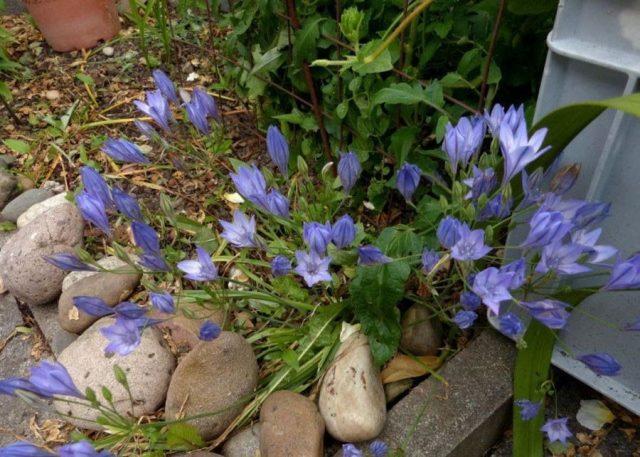
Tritelia is used to decorate low hedges and borders
Tritelia in the country grows well in gravel gardens, rock gardens and rock gardens. The crop successfully takes root on light soil, but in this case it needs to be provided with high-quality moisture.
Conclusion
Photos of tritelia show a beautiful perennial plant, represented by several varieties. The culture is mainly intended for warm regions, but with quality care it can also develop in temperate climates.
Reviews of tritelia flower

